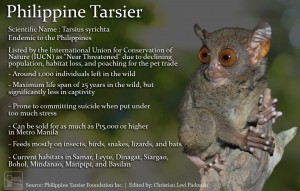New species of tarsier discovered in Dinagat Island
 MANILA, Philippines – International biologists have confirmed the discovery of a new species of Tarsier on the island of Dinagat in Mindanao 25 years after a Filipino biologist first saw the possibility of there being a distinct species.
MANILA, Philippines – International biologists have confirmed the discovery of a new species of Tarsier on the island of Dinagat in Mindanao 25 years after a Filipino biologist first saw the possibility of there being a distinct species.
Rafe Brown, curator-in-charge at the University of Kansas’ Biodiversity Institute said in a statement published on their website that the distinct Dinagat-Caraga tarsier was found to be a different species through DNA testing conducted by Kansas University biologists.
Their testing confirmed a previous study done by Filipino Biologist Dioscoro Rabor in the 1970s.
“The confirmation of Rabor’s early suspicions about the Dinagat Island tarsier population was extremely exciting, and it was very satisfying to affirm his very perceptive early observations,” Brown said in the statement.
“He commented that it looked larger to him and had different shaped fingers and toes. I’m just glad we were able to bring new, modern tools to this problem and identify the Dinagat-Caraga tarsier as a real conservation priority,” he said,
The nocturnal tarsiers are iconic for their large eyes in relation to body size being the world’s smallest primates. They are very popular tourist attractions on the island of Bohol in the Visayas region.
Brown said that the Philippine tarsier was previously classified as a single species that was divided in to three subspecies. With their latest discovery of three distinct “genetic units,” Brown said that conservation efforts can be redirected to the areas where the different species are to ensure the full and effective preserving the species.
“They’re threatened with habitat loss due to development, mining and deforestation from the timber industry,” Brown said. “We need a protected area — such as a national park — in the ranges of each of the genetic units if our goal is to maximally preserve the genetic underpinnings of that biodiversity.”
“On Bohol, where they are a big part of the tourist economy, literally thousands of animals are taken out of the wild, essentially harassed by tourists, and die in captivity due to the stress and inability of their captors to feed them an appropriate diet of live small animals. Tarsiers must eat an enormous amount every night to fuel their high metabolism,” he said.
Several previous incidents were reported of Tarsiers being taken in as pets by people. The tarsiers were kept inside a box and placed in the luggage compartment of busses along with their luggage.
Despite being rescued by authorities in the city, the Tarsiers later died because of the stressful environment.
Tarsiers are classified as “Near Threatened” by the International Union for the Conservation of Nature as they face numerous threats in the wild forest areas of Mindanao and Visayas regions such as mining, deforestation, and human development.
RELATED STORIES
Tarsier, ‘icon of PH tourism’, sought out as pets—foundation
Surprise: Tarsiers found outside Bohol














